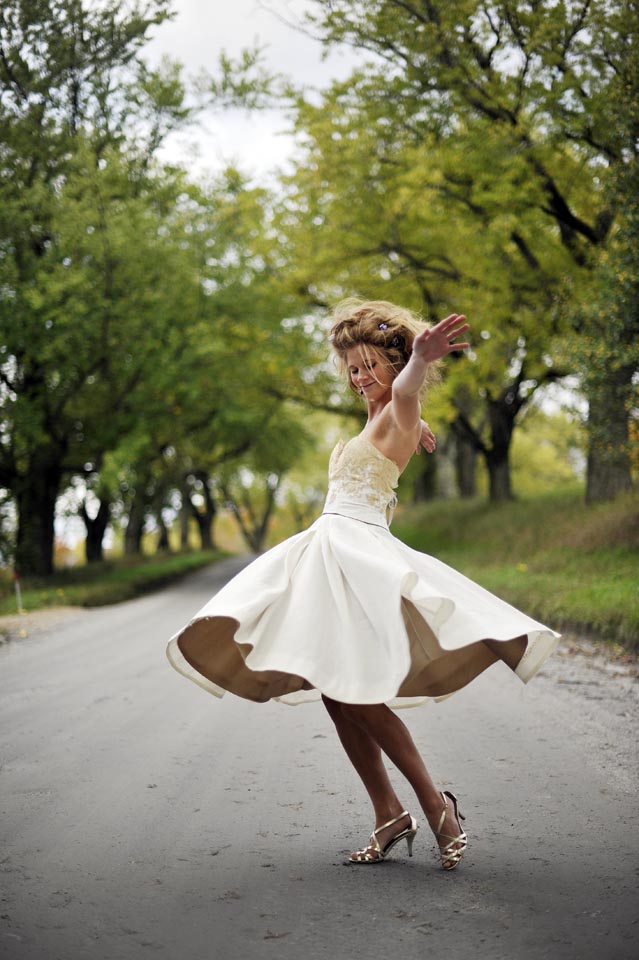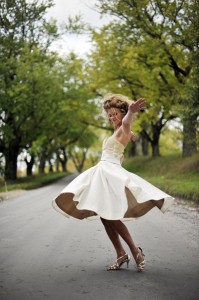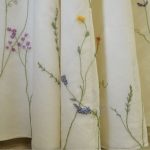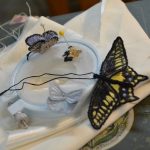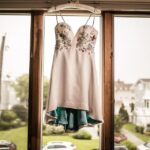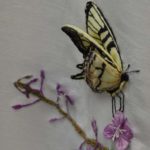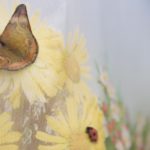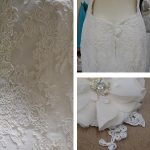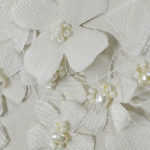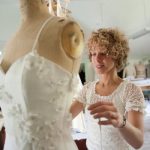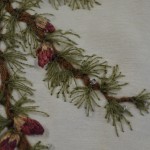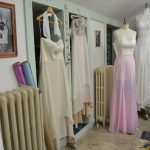Wednesday, February 16, 2011 Revolutionary Verb
Getting behind the seams with a pair of earth-forward designers
By Mary J. Lohnes
Organic cotton, twill, and hemp are fabrics which evoke certain cultural associations—hippies, college students, maybe even survivalists. But for designers Modi Soondarotok and Tara Lynn Scheidet, sustainable fashion is about more than just fabric. To them sustainability means conducting business with their clients in mind and an eye toward future generations.
Passionate Pioneers
“I take such pride in my craft,” Soondarotok says as she looks over the merchandise in her Portland, Oregon shop, IDOM. But she grew up in Bangkok, Thailand where weavers and seamstresses were looked down upon in the community.
“I was always drawn to the structure of things and I would see these women working the looms and I would be enthralled by the birth of fabric and even then, I think, I recognized that fabric has its own life,” she says.
Soondarotok has been in the U.S. since she was twelve and has been designing clothes and accessories for eight years. She studied at the Parson School of Design before working for a string of top designers including Twinkle, Donna Karan and Armani. She relocated to the Pacific Northwest and opened IDOM in 2006.
“I like to think that fabrics have their own personality,” said Soondarotok, “Certain silks won’t drape the way you envisioned on paper, no matter how hard you try to force them. They just won’t do it,” she adds with a laugh.
With a passion also beginning at a young age, Tara Lynn Scheidet of Vermont was born sewing, or so it seems.
“I just love sewing. I can’t remember when I wasn’t doing it,” she laughs, adding that she practically began her career by the third grade. “I made my own doll clothes and quilted before I started making my own clothes. John Paul Gautier was an inspiration, so let’s just say I made some ‘interesting’ high school outfits.”
Scheidet studied at the Fashion Institute of Technology in New York and has worked for several designers including Toshiki and Maryzska. She is the owner of Tara Lynn Studios, Earth Bitch Designs and Tara Lynn Bridal.
Sustainable vs. local
For these two designers, choosing fabric is about more than just reading care labels and picking out colors. Soondarotok’s designs and business decisions have always been influenced by lessons she learned as a child.
“My parents, particularly my father, who was an environmental scientist, guided my interest in social issues, particularly: how do we give people the tools and education they need in order to find or create jobs that provide income and support the community as well,” says Soondarotok, who has her fabric and designs produced by a community of seamstresses in Thailand.
“You hear a lot in the U.S. about assessing and reducing your carbon foot print. But you rarely hear about the decisions and tradeoffs that have to be made. Sewing is a limited skill in the U.S. and there are only a few organic textiles operating in the country,” she says.
In Thailand, Soondaratok can order locally grown, hand-loomed cotton, silk, etc. that has been dyed with berries, bark, roots, and leaves by a textile village in Chiang Mai. Local seamstresses, generally women, produce her designs.
“Doing my production this way allows me to sustain a community,” she says. “No, it doesn’t support Portland directly, but consumers need to ask themselves where the things they use come from? How are they made? How does the production effect lives? I’m proud that my designs can be produced by a seamstress at home, at their own pace while they are taking care of their families. One dress or blouse can support an average family for a week.”
Illogically illegal
“Did you know that Levi’s used to be made of hemp,” Tara Lynn asks before excitedly divulging hemp’s ragged history. Tara Lynn primarily designs one-of-a-kind, handmade, organic bridal gowns, hemp being her fabric of choice. There are only two states in the U.S. where you can grow hemp—North Dakota and Vermont—despite the fact that until it was demonized in 1937, it was one of the primary crops in the U.S.”
We had special machinery in this country designed to reap and produce hemp fabric, explains Scheidet. With the exception of an emergency hemp production operation during World War II, hemp production has been taxed, stigmatized, and regulated to death as the government and powerful companies try to protect us from a plant, she says.
“It is frustrating that people in the U.S. don’t know the difference between hemp and marijuana,” says Scheidet, who buys most of her fabric from a textile distributor on the East Coast, but the fabric has been woven in Romania and China. According to Hemp Traders, one of the largest distributors of hemp products in the U.S., hemp fiber, also known as “bast,” has superior strength and durability, resists rot, is biodegradable and can be bleached without the use of chlorine. Plus, it is one of the few plants that requires relatively no pesticides, zero herbicides and is great for controlling top soil erosion.
Both designers express that they would love to buy more U.S.-produced fabric, but production costs and wages have forced most textiles to close or move their operators overseas.
So few choices, so much design
In addition to high cost and determining who and where your fabric is produced, choosing to use organic cotton, silk, hemp, etc. limits a designer’s options, so fewer choose to do it.
“Using eco-dyes means that your color spectrum is automatically limited,” says Soondarotok, whose dresses and blouses come in rich plum and fuchsia tones, earthy browns and winter grays. “Dying something green is hard because so many of the dye ingredients turn brown in production; chartreuse is pretty impossible. Blues are problematic. Indigo is about as blue as it gets,
” she says, noting that in addition to problems with color trueness, sometimes eco-dyes don’t set well on organic fabric “The methods and formulas the dye houses use have been passed down from one generation to the next. It is specialized knowledge that is not shared with the public. My understanding is that certain natural dyes such as bark, leaves, berries and plants might not adhered to some natural fibers. This can be because of the weave or makeup of the fiber itself,” said Soondarotok. “Likewise, the dye and the components of the dying process such as the water temperature or mordant (the fixing agent) impose limitations that commercial dyes don’t have. Working with natural dyes is challenging, but worth it environmentally. It also makes me more creative and experimental in the actual design process, ” Soodarotok added.
“Some design houses seem afraid to use organic fibers, particularly hemp. It doesn’t help that hemp textiles are limited by their color availability,” says Scheidet. “If I go to NY, I can buy anything, but not in a natural fiber. There are many plain weaves and neutrals available, some crepe, one crinkle and some herringbones but I can’t get a nice tweed or hot pink twill if that is what is in for the season. Of course, if I had the resources and money I could probably have it developed just for me, so I am not saying it is not possible. It is just not conveniently available, said Scheidet. “As the industry expands and more prints and colors are available more designers will be able to use it,” she adds.
In addition to color and pattern limitations, the production process can limit designers’ choices. “I work with natural dyed, hand loomed cotton and silk which have an intense weave, weight, and luster to them. Since the fabric is handmade the colors and fabric (many times) can not be replicated exactly. Sometimes, my garments are one of a kind because I have a limited amount of fabric or am limited by the fabric width due to the loom size which is smaller than those at a standard mill, said Soondarotok.
Scheidet manages to work with a small color palette since the minimum order size on some prints is too large. “If I could afford the quantity, I wouldn’t have enough time or space to cut and sew. Plus, I like working with the vintage cuts because it makes things more unique and creative, “said Scheidet.
“I use hemp blended with silk or organic cotton because it is incredibly soft and luxurious and it is also strong enough to hold appliqué and embroidery,” says Scheidet, who noted that hemp fabric by itself has a broad range of textures and degrees of softness depending on who makes it, the weight of the fabric and the pre-washing process. Hemp linen and muslin in particular are really soft and nice to wear.
Built to last: one part passion, one part individuality
Both designers believe quality and individuality are key elements to good sustainable fashion and strive to create vintage-quality pieces that are made well enough to pass through generations of fashion cycles.
“Fashion is growing into a quantity over quality dynamic that I don’t like. I look back on my childhood and remember seeing women with very little money who owned one or two beloved pieces that they wore over and over again, “says Soondarotok. “They treasured that dress or jacket, so I work hard to design classic pieces that a woman can buy, mix into her existing wardrobe, and pass on to the next generation.
“And the most basic level of fashion, she notes, “Life is hard enough. Shopping should be fun.”
For Scheidet, working with clients one-on-one and her love of fabric and craft have influenced her gown and jacket designs, which incorporate delicate embroidery and appliquéd butterflies, insects and flowers.
“I have been collecting fabric scraps my entire life. As a kid, people would just drop off bags of scraps from projects or old fabric they found while cleaning their parents’ houses, “she says. “When I was in college I worked in Hell’s Kitchen and I would walk all the way over to the garment district with this wheelie cart and pick up scraps and fabric swatch cards they were throwing away.”
She took inspiration from books from the 1970’s, an era in which wearable art was popular. She experimented with incorporating these brilliant scraps into her designs, she says.
“I once did a small production run on a line of jackets and it bored me—every jacket, identical to the next, blah. “She says. Now she works directly with the client, asking a lot of questions, gathering measurements, and sending them fabric swatches along with a couple of sketches of designs. “If they have a tight budget, I might use vintage laces, beaded trims, and sequined bits, “Scheidet says, adding that each dress becomes a relationship for her.
“You become friends as a result of working so closely together. Whether I am taking apart a dress from the 50’s and making a copy of it for the bride, or refashioning it into floral lace pins and hand bags for the wedding, each project is a journey belonging to me and the client. It is a culmination of our relationship.”
For both of these designers, sustainable fashion means designing clothes that go on to have a rich, many-storied life of their own.
Tara Lynn
935 US Route 5
Sutton, VT 05867
Original Article at: https://revolutionaryverb.wordpress.com/2011/02/16/green-the-new-color-of-fashion/

